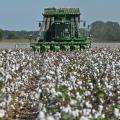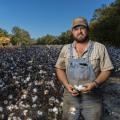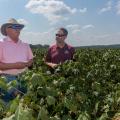Cotton
Cotton is a major crop in Mississippi. In 2014, it ranked fourth behind poultry, forestry, and soybeans in state commodities, with $403 million dollars of revenue.
Mississippi producers planted approximately 420,000 acres of cotton last year. This number seems to fluctuate depending on weather, price of production, and current commodity markets.
The highest acreage recorded in Mississippi was in 1930 when 4.163 million acres of cotton were planted. The highest production year was 1937 when 2.692 million bales were produced over 3.421 million acres. The highest cotton yields were received in 2004 with 1034 pounds of lint produced per acre. This same year there were 2.346 million bales produced, almost as much as in 1937 with only one third of the acreage. This yield beat the previous yield of 934 lbs in 2003.
Many changes have occurred over the last few years in cotton production:
- Boll Weevil Eradication efforts have been successful and the Boll Weevil is no longer a problem pest in Mississippi.
- Transgenic Cotton Varieties containing the following Genes: Roundup Ready, BollGard I & II, and WideStrike and Liberty Link have become very popular, and the majority of the cotton acres in Mississippi are planted in some type of transgenic variety.
- Growers are realizing the benefits of reduced tillage programs to increase yields and profit margins.
The major insect pests in cotton have also shifted. The Boll Weevil used to be the main pest, followed by the Tobacco Budworms and Cotton Bollworms. However, with the introduction of the new technologies and success of the Boll Weevil Eradication program, the Tarnished Plant Bug has now become the number one pest in Mississippi cotton production.
Cotton is and will continue to be a major crop in the state of Mississippi. With the current varieties and technology available, average cotton yields in Mississippi may have risen to a higher plateau than in years past. Technological advances in transgenic cotton varieties have allowed cotton to be managed and produced easier than ever before, and these advances continue to be major reasons that yields have continued to increase over the past few years.
Frequently Asked Questions
- Questions following a hurricane
- How do you estimate yield by boll counting? PDF
- How do you estimate potential yield loss? PDF
- Will foliar feeding seedling cotton increase yield?
- What are Mississippi's freeze dates?
- Can you tell me about sprayer calibration?
- What is the recommended seeding rate for cotton?
- What should be the soil temperature at planting time?
- What percentage of my crop should I plant in Bt?
- What final live plant population should I target?
- What variety, or varieties should I plant?
- Should I replant?
- What should I do about hail damage?
Cotton Defoliation
Cotton Disease and Damages
Nutrient Management
Publications
News
RAYMOND, Miss. -- Mississippi’s agriculture industry remains vibrant with an overall production value estimated at $9 billion, despite a drop in row crop prices.
STARKVILLE, Miss. -- Agricultural producers and consultants are encouraged to register for the annual Mississippi State University Row Crop Short Course.
Success Stories
After graduating from college, David Hey got out of farming to be a truck driver, but before long he realized he wanted back in.
Gaddis & McLaurin might sound more like the name of a law firm than a general store, but the name is synonymous with all manner of dry goods in the Hinds County community of Bolton and has been since the 1870s.
Sledge Taylor is no stranger to cover crops —he first planted vetch on 100 acres of his Panola County farmland in 1979—but he has ramped up his cover crop usage and added other sustainable agricultural practices over the past 15 years.








